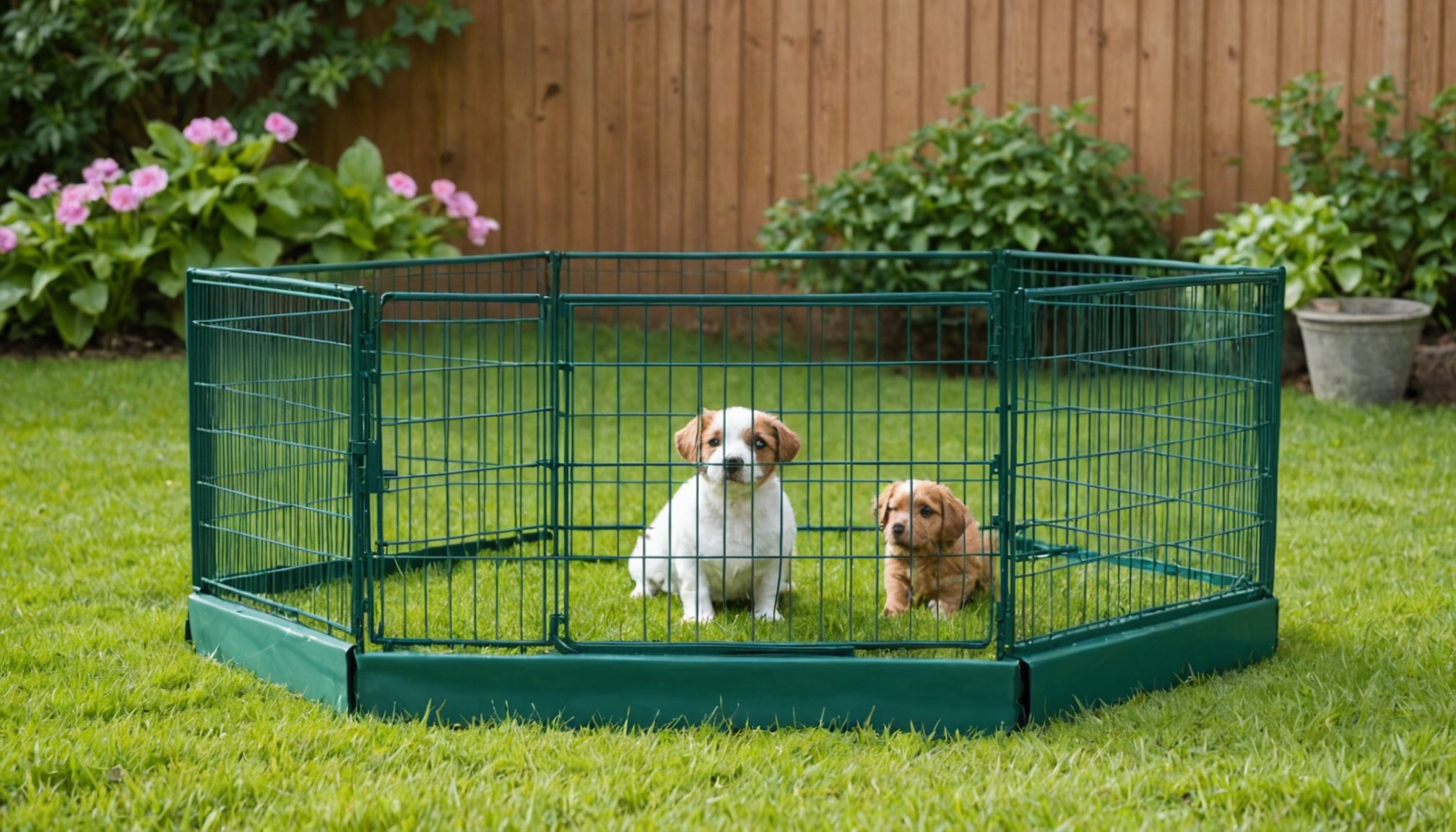Introduction to Outdoor Spaces for Small Pets
Creating outdoor spaces for small pets, such as rabbits and guinea pigs, is significantly beneficial. It allows them to experience fresh air, sunlight, and natural stimuli. However, ensuring small pet safety while they enjoy their outdoor time is paramount.
When designing outdoor spaces, focus on security. Enclosures should be sturdy and escape-proof to protect against predators. Materials like galvanized wire mesh are excellent choices for fencing. Moreover, ensure shading to prevent overheating, which can be detrimental to a pet’s health. Including elements like tunnels and hideouts further enhance the safety and enrichment for pets.
Also read : Caring for Birds with Mobility Challenges: Your Ultimate Guide to Ensuring Their Comfort and Well-Being
Grassy or natural terrains promote enrichment, encouraging foraging and exploratory behaviors. Such enrichment for pets can significantly boost their mental well-being and reduce stress. Additionally, interactive features like climbing structures and designated digging areas support physical health, addressing the pet’s exercise requirements.
Incorporating small pet safety elements doesn’t have to compromise design. Blend aesthetics with functionality by adding visually appealing, yet secure, plantings. Always avoid toxic plants, as they pose severe risks. Overall, thoughtfully designed outdoor spaces enhance a pet’s quality of life, contributing positively to their health and happiness.
Topic to read : Creating a Calm Oasis: Essential Tips for a Stress-Free Home for Your Rescue Cat
Designing Safe Outdoor Enclosures
Creating a secure pet enclosure is essential for ensuring outdoor safety. When pet-proofing, consider various factors to keep your furry companions secure and happy. Begin with selecting the right location.
Selecting the Right Location
Proper site selection is critical for a secure pet enclosure. Prioritize areas with ample shade and minimal wind exposure. Ensure the ground is level to prevent escape routes or injuries. Critically, consider visibility from the house for easy supervision.
Building Materials and Tools
Using the right building materials and tools guarantees durability and safety. Opt for robust fencing materials like chain link or welded wire panels. These options offer sturdiness while allowing visibility and airflow. Tools such as a heavy-duty stapler, safety gloves, and a measuring tape are will help ensure a properly fastened structure.
Common Mistakes to Avoid
Avoid design errors that could compromise security. Failing to account for weather changes can weaken structures over time. Ensure the enclosure’s height is sufficient to prevent climbing or jumping over. Also, avoid subpar materials that deteriorate quickly, putting pets at risk. Moreover, forgetting to check for toxic plants or sharp objects within the enclosure might lead to health issues or injuries for pets.
Enrichment Activities for Small Pets
Ensuring your small pet receives adequate mental stimulation and exercise is crucial for their health and happiness. Engaging in a variety of pet enrichment activities can significantly enhance their quality of life by catering to their natural instincts and behaviours.
Interactive play is a fantastic way to challenge your small pet’s mind while providing necessary exercise. Some effective options include maze toys and treat puzzles. These not only stimulate your pet mentally but also keep them physically active as they sniff and work their way through the challenges. Such activities are excellent for meeting their cognitive needs.
In addition to toys, you can incorporate natural elements into your small pet activities. Simulating a natural environment through the use of sticks, leaves, and rocks encourages exploration. By providing opportunities for digging or climbing, you help satisfy their innate instincts and curtail any boredom-related behaviours.
Remember, each activity should focus on your specific pet’s preferences and capabilities. Regularly switching up and diversifying activities keeps the experience fresh and engaging for your companion. Ultimately, well-chosen enrichment activities lead to a healthier, happier, and more content small pet.
Suitable Plants and Landscaping for Small Pets
Creating a safe and enjoyable environment for small pets involves thoughtful pet landscaping that incorporates both safety and natural beauty. Ensuring the inclusion of safe plants for pets is crucial to prevent any accidental poisoning or harm.
Types of Pet-safe Plants
When designing a landscape for small pets, some excellent choices of safe plants for pets include spider plants, Boston ferns, and rattlesnake plants. These non-toxic plants not only add greenery but also ensure your pets stay unharmed if they decide to explore or nibble.
Creating Shelter and Shade
Pet landscaping should also consider the environmental needs of pets, such as providing shelter and shade. Creating spaces with overhanging branches, shrubs, or a small natural pergola can shield pets from harsh sun or rain, ensuring their comfort throughout the day.
Seasonal Plant Considerations
Incorporating natural elements that adapt to seasonal changes is important. During colder months, choosing evergreen plants or creating windbreaks with dense shrubs can offer additional warmth and protection. For warmer periods, integrating plants that provide shade and retain moisture helps keep the environment cool and inviting. Adapting your pet landscape with the changing seasons ensures optimal comfort and safety for your small pets year-round.
Monitoring Pet Well-being in Outdoor Environments
When caring for your pet outdoors, understanding physical and behavioral signs of well-being is crucial. Pets often communicate their needs and discomfort through cues. For instance, a dog wagging its tail and playing actively typically indicates happiness, whereas excessive panting or drooling might signal distress or overheating. Regularly assessing these signs ensures effective outdoor pet care.
Supervising your pets actively and interacting with them provides an additional layer of pet health monitoring. Try to spend dedicated time observing your pets’ behaviours and problem-solving when necessary. For example, even small changes like a reduction in energy levels could point towards a health issue. Engagement helps in catching these subtle cues early.
Addressing potential hazards from wildlife is a critical component of outdoor pet care. Wildlife can pose threats both directly and through signs of distress in your pet. Some animals bring diseases, while others may physically harm pets. Use strategies such as secured fencing and monitoring tools to mitigate these risks.
Remember, when your pet spends time outdoors, maintaining proactive measures ensures their safety and well-being, while allowing them to enjoy nature fully and safely.
Adapting Outdoor Spaces for Seasonal Changes
Adapting your pet’s outdoor enclosures for different seasons is essential in maintaining their well-being. Understanding the demands of seasonal pet care helps create a safe and comfortable habitat for your furry friends.
Preparing for Extreme Weather
Extreme weather conditions require specific adaptations to ensure pet safety. Winter precautions might involve insulating enclosures to protect against chilling winds, while providing appropriate bedding to retain warmth. For summer, it’s vital to offer shaded areas, water sources, and ventilation to prevent overheating. Installing temporary shelters or adapting enclosures with detachable panels are practical ways to handle seasonal changes. Make sure to regularly check weather forecasts to proactively adjust setups for sudden weather shifts.
Behavioral Adjustments for Seasons
Seasons influence pet behavior significantly. Pets might become more lethargic during colder months or more active during warmer periods. Recognizing these patterns enables proactive seasonal pet care. Adjusting exercise routines and feeding schedules can help in managing their energy levels efficiently. This might mean increased walks during chilly winters to combat cabin fever or shorter, earlier outings in the heat of summer.
Seasonal Enrichment Ideas
Keeping pets engaged year-round demands creativity. Introduce toys that encourage seasonal behavior, such as puzzle toys with treats in winter to burn energy indoors, or water-based activities in summer to stay cool. Rotating these enrichment items keeps your pets mentally stimulated and happy throughout the year.











